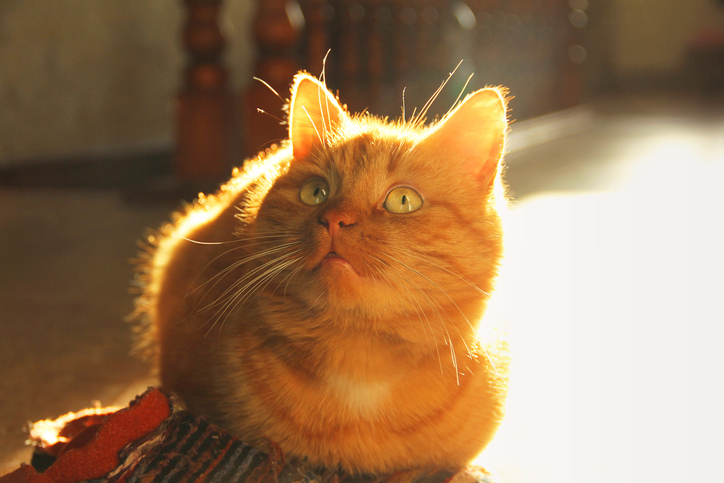5 Spiritual Lessons We Learn From Cats
Getty/Leoba
Cats are spiritual—or at least they can help us be spiritual. Here are five lessons your spiritual cat wants to teach you.
Shockingly, there were no kittens in my Protestant childhood Bible. Alas, the scripture was silent on cats, unless you considered lions (or you were Catholic—a single deuterocanonical verse, Baruch 6:22, includes the word cat).
Yet, lessons from inspired felines can be found in many of the world’s wisdom traditions. In Islam, a story is told of the prophet Muhammad’s beloved cat, Muezza, who had fallen asleep on his shirt. Needing the shirt for prayer time, yet reticent to disturb the cat, Muhammad cut off the shirt’s sleeve. In the eighth century, cats in China helped with divination. And, although cats sometimes get a bad rap in Indic spiritualities, how a mama cat carries kittens is used as a delightful metaphor for the soul’s journey from one birth to another. And who doesn’t immediately think of the role of feline familiars in Earth-based spiritualities?
Admittedly, it’s hard to top the ancient Egyptians. Considering cats semidivine, they modeled what it means to grieve a cherished animal companion: When a cat passed on, it’s human family would shave off their eyebrows to demonstrate their grief publicly.
Today, honor cat spirituality―while keeping your eyebrows intact―with these five helpful examples from the four-legged inspirations.
Cat Spirituality: Alternate Naps and Activity
Cats seem to have an inherent sense of Tao, alternating between sleep and action, then napping, of course. Sleeping almost 15 hours a day total, cats flow between these states with superb stretching skills. Humans go, go, go till we drop, drop, drop―dividing our days into two distinct periods of wake and sleep.
Try it: Each time you transition from sitting to standing, stretch your arms as high up as possible, separating your fingers and toes widely. Sometime today grab a short catnap.

Birds Are Good Meditation Partners
No, birds are not necessarily what’s for dinner. Cats love objects that move because they are easier to see. In fact, many slow-moving objects you can detect appear stationary to cats. The fluttering of bird wings outside a window can be an endless source of still—yet present—sitting for a kitty.
Try it: Create a cozy spot near a window where birds congregate—or head outdoors. Sit silently, observing movement around you. Avoid judging the bird for its color, type, or activity. Just follow the flight, letting thoughts pass.
Bathe Often to Emulate Cat Spirituality
Water permeates sacred rituals, from washing before prayer to full-body mikvah or baptism. Most cats abhor a bath, instead they spending up to a third of their day grooming with the lick-my-paw method.
Try it: Fill a pretty bowl with fresh water. Add slices of cucumber or orange, or try fragrant flower petals. Find a location where you won’t be bothered by any of the human or furry members of your family. Create a small altar for the bowl. Place a few of your favorite sacred objects nearby. During the day, return often, dipping your fingers in, then gently touching your forehead, temples, chin, and wrists.
Use Your Words Judiciously
My two fluffy companion animals have very different communication patterns. Buba-ji is loquacious, with an incredible range of “words” he uses nonstop. Deacon, on the other hand, rations his vocalizations as if they are precious jewels. Consequently, when he speaks, we are more apt to listen.
Try it: Use these guiding principles from the Buddhist tradition to check if your thought truly needs to be conveyed. It is spoken at the right time. It is spoken in truth. It is spoken affectionately. It is spoken beneficially. It is spoken with a mind of goodwill.
Spiritual Cats: Purring Is Powerful
Cats purr continuously at fluctuating levels that can indicate contentment, solicit attention, relieve pain, or promote healing. Studies have shown cat purrs can promote tissue regeneration and promote bone health. Vibrational healing is not limited to the feline world. Practically everything on our planet vibrates, whether we can see or hear it, or not.
Try it: Get out to a gong bath. Or if you’re homebound, consider jumping into your parked car, gently closing your eyes, and submerging yourself in the pulsing vibrations of your favorite kirtan hits.
Or you could do none of these things and simply sit with your cat. Petting at an optimal rate of 40 strokes per minute may increase both your and Fluffy’s oxytocin, suggests Takefumi Kikusui, an animal behaviorist at Azabu University in Japan. “Oxytocin is a hormone associated with trust and maternal bonding,” he explains. “It increases when you’re close to someone you love and gives you that warm fuzzy feeling.”
Further, a cat on your lap becomes an enticing reason to be still―you know, the old “I can’t. I have a cat on my lap!” excuse. Forget the apologetics. Perhaps the greatest lesson we can learn from cats is to rest. In fact, my cats and I are just about to settle down for a purr-fect viewing of our favorite sacred narrative, Star Wars, which, for some ridiculous reason―like my childhood Bible―lacks cats. Buba-ji and Deacon don’t mind. They seem to grasp the paw-some power of the Force.
Want to dive deeper? Here are 10 ways pets improve mental health.


